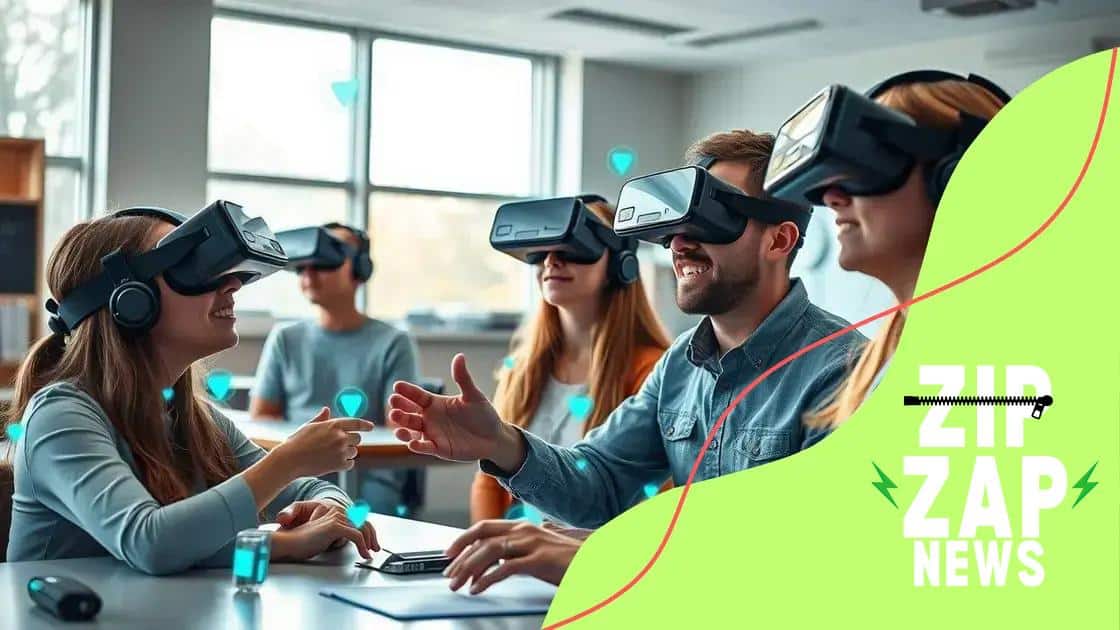Virtual reality as a tool for digital education

Virtual reality as a tool for digital education engages students through immersive experiences, improving retention and understanding while presenting challenges such as costs, technical issues, and the need for proper teacher training.
Virtual reality as a tool for digital education is transforming how students learn and engage with content. Have you ever wondered how immersive experiences could shape the future of education? In this article, we’ll dive into the fascinating world of VR in classrooms and beyond.
Understanding virtual reality in education
Understanding virtual reality in education opens doors to immersive learning experiences that traditional methods simply can’t match. By utilizing immersive environments, educators can transport students to different times and places. This enhances engagement and caters to various learning styles.
What is virtual reality?
Virtual reality, or VR, is a computer-generated simulation of a three-dimensional environment that can be interacted with using special equipment, such as headsets. This technology allows users to engage their senses in ways that bring learning to life.
Key components of virtual reality in education:
- Immersive experiences that engage students.
- Interactive content tailored to individual learning needs.
- Access to remote and historical locations that enhance understanding.
- Real-time feedback that helps improve skills and knowledge.
With VR, students can explore the solar system, walk through ancient civilizations, or even practice surgical procedures – all from their classroom. This kind of hands-on learning not only captivates students’ attention but also helps them retain information better. As they navigate through these experiences, learners are encouraged to ask questions and solve problems in a simulated environment.
Moreover, the adaptability of virtual reality makes it suitable for diverse subjects ranging from history to science. Teachers can design lessons that appeal to different learning preferences, whether visual, auditory, or kinesthetic. This flexibility ensures that every student has the opportunity to learn effectively.
By incorporating virtual reality into their curriculum, educators are not just teaching facts – they are developing critical thinking and problem-solving skills. As students tackle challenges within these virtual environments, they become active participants in their learning journey.
Benefits of virtual reality for students
The benefits of virtual reality for students are vast and impactful. With this technology, learning becomes an adventure that stimulates curiosity and enhances understanding. By immersing learners in interactive environments, education shifts from traditional methods to a more engaging experience.
Enhanced Engagement
Students become naturally more engaged when they can participate in lessons through virtual reality. Instead of just listening to lectures, they actively explore concepts. This hands-on approach keeps their attention focused and encourages participation.
Improved Retention
Research shows that students retain information better when they experience it in a memorable way. With virtual reality, learning becomes vivid and retention increases. Experiences in a virtual world create lasting memories that traditional textbooks may not.
Real-World Applications
- Simulations that prepare students for real-life scenarios.
- Experiences that bridge theoretical knowledge and practical application.
- Exploration of complex topics through a safe, controlled environment.
- Opportunities to practice skills without the risks associated with real-life situations.
For example, medical students can practice surgeries in a virtual environment without jeopardizing patient safety. This practical experience is essential as it builds confidence and competence before applying knowledge in real situations.
Additionally, virtual reality caters to different learning styles. It combines visual, auditory, and kinesthetic learning, making it suitable for all types of students. This adaptability helps ensure that every learner can thrive and succeed.
The collaboration in VR also fosters teamwork. Students can work together on projects, solving problems and exploring environments simultaneously. This shared experience can enhance communication skills and build essential soft skills for the future workforce.
How to implement virtual reality in classrooms

Implementing virtual reality in classrooms can transform the learning experience for students. It allows educators to create immersive lessons that engage and inspire. By following a few key steps, teachers can successfully integrate this technology into their classrooms.
Assessing Needs and Objectives
Before introducing virtual reality, it’s important for educators to determine what they hope to achieve. This might include enhancing student engagement or providing a deeper understanding of complex topics. Setting clear goals helps guide the implementation process effectively.
Selecting the Right Technology
Choosing the right VR equipment is essential. Schools can choose from various headsets and software tailored for education. It’s crucial to consider factors such as:
- User-friendliness for both teachers and students.
- Cost-effectiveness for the classroom budget.
- Content availability that aligns with the curriculum.
- Technical support for troubleshooting.
Once the right tools are selected, teachers can start crafting lessons that make the most of virtual reality. Collaborating with tech-savvy educators can help streamline the process.
Next, training is key. Educators should familiarize themselves with the chosen technology to maximize its benefits. Participating in workshops or training sessions allows teachers to learn effective strategies for integrating VR into their lessons.
Creating Interactive Lessons
When designing VR lessons, it’s beneficial to focus on interactivity. Assignments should encourage exploration and engagement. For instance, students could take virtual field trips, conduct science experiments, or interact with historical events, immersing themselves in a dynamic learning environment.
Evaluating the Impact
After implementing virtual reality, it’s important to assess its effect on student learning. Gathering feedback through surveys or discussions can provide insight into what works and what needs improvement. Tracking student progress can also help educators see how VR impacts achievement.
Challenges faced in using virtual reality for education
Using virtual reality in education brings numerous advantages, but it also presents several challenges that educators must address. These obstacles can impact the effective implementation of VR technology in classrooms.
High Costs
One of the main challenges is the cost associated with virtual reality equipment. Headsets, software, and necessary technical infrastructure can be expensive. Many schools face budget restrictions that make it difficult to acquire the latest technology.
Technical Issues
Technical problems can arise during the use of VR. Issues with hardware compatibility or software glitches can disrupt lessons. Educators need to be prepared for these challenges and plan for them accordingly. This includes having IT support readily available, which can be a strain on resources.
Training and Familiarization
Another significant challenge is ensuring that teachers are adequately trained in virtual reality technology. Many educators may not feel comfortable with new tech tools, which can hinder their ability to deliver effective lessons. Continuous professional development is essential for teachers to feel confident using VR in their classrooms.
Student Discomfort
Some students may experience discomfort or motion sickness when using VR headsets. This can affect their ability to engage fully in virtual reality experiences. It’s essential for educators to monitor students’ reactions and make adjustments as necessary, such as limiting time spent in VR or providing breaks.
Curriculum Integration
Successfully integrating virtual reality into the curriculum can prove challenging. Educators must find ways to align VR lessons with learning standards and objectives. It requires creativity and planning to develop lessons that are both engaging and educational.
Future trends of virtual reality in learning
The future of virtual reality in learning looks promising with continuous advancements in technology. As educators embrace this innovative approach, new trends are emerging that could shape how students learn in the coming years.
Increased Accessibility
One major trend is the effort to make virtual reality more accessible to all students. As prices for VR technology decrease and mobile VR options become more available, schools with limited budgets will have opportunities to implement this engaging tool. Efforts to democratize technology ensure that students from various backgrounds can benefit from immersive learning experiences.
Integration with Augmented Reality
As technology progresses, the integration of virtual reality with augmented reality (AR) is becoming more common. This combination allows students to experience content in multiple ways, blending the real world with digital elements. For example, a student learning about ecosystems could interact with both virtual animals and real-world environments, enhancing their overall understanding.
Focus on Social Learning
Collaboration in VR will become increasingly important as educators aim to foster social learning. Students will work together in virtual spaces, solving problems and exploring topics collaboratively. This interaction encourages teamwork and communication while making learning more engaging.
Personalized Learning Experiences
The use of artificial intelligence in conjunction with virtual reality will lead to more personalized learning experiences. Students can benefit from adaptive learning paths tailored to their strengths and weaknesses, helping them master concepts at their own pace. This approach addresses the varied needs of learners, ultimately contributing to better educational outcomes.
Focus on Lifelong Learning
Finally, the trend toward lifelong learning will continue to influence how virtual reality is used in education. As adults seek to upskill and reskill in an ever-changing job market, VR offers an engaging way for professionals to learn new concepts and practices. VR-based training programs will become essential for businesses looking to enhance employee development.
In conclusion, virtual reality is set to change the face of education in exciting ways. It engages students more effectively and enhances their learning experience. As we look to the future, accessibility, collaboration, and personalized learning will become key trends. By embracing these innovations, educators can create dynamic classrooms that cater to all learners and prepare them for a rapidly evolving world.
\n
\n
FAQ – Frequently Asked Questions about Virtual Reality in Education
What are the key benefits of using virtual reality in education?
Virtual reality enhances student engagement, improves knowledge retention, and allows for real-world applications through immersive learning experiences.
What challenges do schools face when implementing VR technology?
Schools often face high costs, technical issues, and the need for proper teacher training to effectively utilize virtual reality in the classroom.
How can virtual reality complement traditional learning methods?
VR can provide hands-on experiences and simulations that enhance theoretical knowledge, making learning more dynamic and interactive.
What future trends are emerging in the use of virtual reality for education?
Future trends include increased accessibility, integration with augmented reality, personalized learning experiences, and a focus on lifelong learning.





